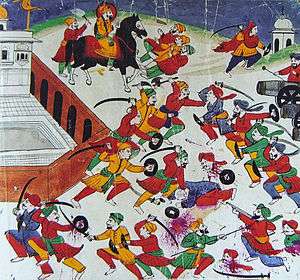Battle of Muktsar
| Battle Of Muktsar | |||||||
|---|---|---|---|---|---|---|---|
| Part of Mughal-Sikh Wars | |||||||
 | |||||||
| |||||||
| Belligerents | |||||||
|
|
| ||||||
| Commanders and leaders | |||||||
|
|
| ||||||
| Strength | |||||||
| unknown | 41 | ||||||
| Casualties and losses | |||||||
| unknown | |||||||
The Battle of Muktsar or Battle of Khidrāne Dee Dhāb took place on 8 May 1705,[9] (21 Vaisakh 1762 Bikrami calendar)[10] following the siege of Anandpur. In 1704, Anandpur was under an extended siege by the allied forces of the Mughals and the hill chiefs.[11]
During the siege 40 men, led by Bhai Maha Singh, Puar Rajput Sikh by caste, son of Shaheed Bhai Mani Singh, Diwan of the Tenth guru and Jathedar of Amritsar during tenth guru, wrote letters of bedava (abandonment of a Sikh from his Guru[12]) to Guru Gobind Singh. They arrived in the village of Jhabal where a Sikh woman named Mai Bhago, upon hearing their tale of desertion, motivated them into returning to Guru Ji at Anandpur Sahib.
The 40 deserters with Mai Bhago returned to seek out Guru Gobind Singh, and joined him near Khidrāne Dee Dhāb preparing for battle against the Mughals. They fought, defeated the Mughals[13] and died in the following battle. The guru, finding the dying Maha Singh on the battlefield after the battle, forgave him and his compatriots, tore up their letters of bedava, and blessed them for their service.[14] The place was later renamed Muktsar, literally meaning The Pool of Liberation.[15][16] Mai Bhago survived the battle and stayed on with Guru Gobind Singh Ji as one of his bodyguards.
The Mela Maghi is held at the holy city of Muktsar Sahib every year in memory of the forty Sikh martyrs.[17] The Maghi Mela is held on 1 Magh in January due to Sikhs already gathering in Gurdwaras on Maghi since the third Guru Amar Dass Ji established Maghi as a Sikh festival.[18]
References
- ↑ Singha, H. S (2000). The encyclopedia of Sikhism (over 1000 entries). Hemkunt Press. p. 148. ISBN 978-81-7010-301-1. Retrieved December 22, 2011.
- ↑ Jacques, Tony. Dictionary of Battles and Sieges: F-O. p. 695. ISBN 978-0-313-33536-5.
- ↑ Dhillon, Dr Dalbir Singh (1988). Sikhism – Origin and Development. Atlantic Publishers and Distributors. p. 151.
- ↑ Sagoo, Harbans (2001). Banda Singh Bahadur and Sikh Sovereignty. Deep & Deep Publications.
- ↑ Jacques, Tony. Dictionary of Battles and Sieges: F-O. p. 695. ISBN 978-0-313-33536-5.
- ↑ Fenech, E. Louis; Mcleod, H. W. Historical Dictionary of Sikhism. Rowman & Littlefield. p. 64. ISBN 978-1-4422-3601-1.
- ↑ McLeod, W. H. (2009). The A to Z of Sikhism. Scarecrow Press. p. 134. ISBN 978-0-81086-344-6.
- ↑ Fenech, E. Louis; Mcleod, H. W. Historical Dictionary of Sikhism. Rowman & Littlefield. p. 64. ISBN 978-1-4422-3601-1.
- ↑ Tony Jaques (2007) Dictionary of Battles and Sieges: F-O. Greenwood Publishing Co.
- ↑ Shera Siṅgha (Giānī.) (1967) Social & political philosophy of Gobind Singh. Sterling Publishers (P) Ltd.
- ↑ Surinder Singh Johar (1998). Holy Sikh Shrines. M.D. Publications Pvt. Ltd. p. 46. ISBN 978-81-7533-073-3.
- ↑ "Bedava". The Sikh Encyclopedia. Retrieved 24 September 2013.
- ↑ Sagoo, Harbans (2001). Banda Singh Bahadur and Sikh Sovereignty. Deep & Deep Publications.
- ↑ "Chali Muktay: The Forty Liberated Ones". Sikh Information. Retrieved 29 August 2014.
- ↑ R. K. Pruthi (2004). Sikhism And Indian Civilization. Discovery Publishing House. p. 106. ISBN 978-81-7141-879-4.
- ↑ Linda Edwards. A brief guide to beliefs. Westminster John Knox Press. ISBN 0-664-22259-5.
- ↑ Fenech, E. Louis; Mcleod, H. W. Historical Dictionary of Sikhism. Rowman & Littlefield. p. 65. ISBN 978-1-4422-3601-1.
- ↑ Jawandha, Major Nahar Singh (1 January 2010). "Glimpses of Sikhism". Sanbun Publishers. Retrieved 14 September 2016 – via Google Books.